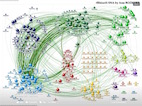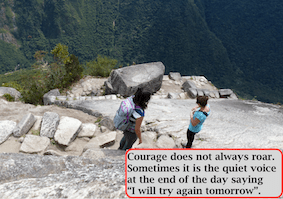Teachers activate learning. They are catalysts for ideas and concepts. With a thoughtful question or timely prompt, they set thinking into motion. This spurs action from their students – actions in thought or physical tasks. In the truest scientific sense, catalysts remain unchanged by this interaction but in knowledge building, the catalyst becomes transformed by the sharing and sense-making process.
 This past week an image and tweet was a catalyst for my own thinking. Harold Jarache’s blog post Knowledge Catalysts was the source of the image and tweet. I immediately thought of those people who are my knowledge catalysts – those who prompt me to think, filter, curate, and do within digital spaces. These people are high on the sense-making scale, high on the sharing scale and engage in diverse knowledge networks. They go beyond consuming or connecting by modelling an expertise in domains such as higher ed, leadership, digital proficiency etc.
This past week an image and tweet was a catalyst for my own thinking. Harold Jarache’s blog post Knowledge Catalysts was the source of the image and tweet. I immediately thought of those people who are my knowledge catalysts – those who prompt me to think, filter, curate, and do within digital spaces. These people are high on the sense-making scale, high on the sharing scale and engage in diverse knowledge networks. They go beyond consuming or connecting by modelling an expertise in domains such as higher ed, leadership, digital proficiency etc.
What makes someone a catalyst in digital places? How would you describe the catalysts that keep you coming back to digital spaces?
Catalysts are quietly courageous. They put themselves ‘out there’ on a regular basis. They leap off the ledge into the unknown digital spaces and test out the waters of new technologies while sharing their insights and failures. My catalysts shape my practices and decisions by leading the way. My recent foray into writing a chapter for an e-book resulted from one catalyst. Jumping into trying Slack and virtual connecting using Google Hangouts came from other catalysts. Joining ISTE PLN’s in a leadership role came from yet another catalyst, Kendra Grant. Catalysts don’t lead you off the cliff without holding your hand or being at your side – digitally speaking. They guide your first steps and are probably jumping with you.
Catalysts glow in the dark. In Seth Godin’s post Glow in the Dark he talks about people who create energy, generate urgency, and restart momentum, but most importantly they know how to regenerate. Catalysts take time to sit and ponder, walk and wonder, listen deeply or watch attentively. My catalysts glow in digital spaces where they illuminate ideas, shed light on tips or tools, or position the lens onto something I may not have considered. Dave Cormier, of Rhizomatic Learning notoriety, recently illuminated the idea of moving from ‘we to them’ or was that ‘them to we’ in open, online communities. This connects to notions of hospitality, belonging, and presence in digital spaces.
Catalysts ask thought provoking questions. They take everyday events and turn them into opportunities to delve a little deeper. Their questions are sometimes conversation starters, as Aviva Dunsinger’s blog posts often become. The comment section is as rich in thought provoking discourse as the blog post itself. Some catalysts prompt an inquiry or focused exploration such as the one by Stephen Hurley around supporting children for the first day of school. By asking these questions, a catalyst sets thinking in motion and connections begin to revolve.
Catalysts are storytellers. They share compelling personal narratives about what they do, experience or explore in digital or physical spaces. These stories are shared openly as an effort to make sense of something. Catalyst stories often cross the quasi digital lines to engage new audiences. My catalysts come from diverse physical spaces (local, regional, national, global) and a variety of learning networks (teachers, leaders, thinkers, higher ed, K-12, humanities, sciences, business). Maha Bali’s Reflecting Allowed blog is one example of storytelling in, of, & on action. Sylvia Duckworth creates catalytic conversions with her array of sketch notes.
Catalysts are invitational. They suggest, proposition and present options. Whether it’s an open field or secure sandbox, catalysts will invite others to explore, experiment and engage. These spaces are sometimes created by the catalyst (my recent Slack encounter) or one they’ve found that they’d like to share with others (such as the invitation to join in a group to explore the Human Centered Design course with Whitney Kilgore). The OSSEMOOC network is inviting leaders and educators across Ontario to connect and engage in digital spaces.
 Being a catalyst is a reciprocal relationship in knowledge networks. My catalysts entice a reaction from me to create, curate, connect, do, or think in some way. These reactions and actions may then be a catalyst for someone else. Sometimes these symbiotic events can be cataclysmic, creating great change in all those involved. Usually catalytic events are slow moving, revolving and evolving dances with ideas where collisions can initiate new directions. My catalysts engage with me in this dance in digital spaces, with digital technologies, creating new digital artefacts that become catalysts for others.
Being a catalyst is a reciprocal relationship in knowledge networks. My catalysts entice a reaction from me to create, curate, connect, do, or think in some way. These reactions and actions may then be a catalyst for someone else. Sometimes these symbiotic events can be cataclysmic, creating great change in all those involved. Usually catalytic events are slow moving, revolving and evolving dances with ideas where collisions can initiate new directions. My catalysts engage with me in this dance in digital spaces, with digital technologies, creating new digital artefacts that become catalysts for others.
Who are your catalysts? Where do collisions in the dance occur for you? When has a cataclysm occurred and what was the outcome?



Teachers as activators is a powerful image – and exciting as well! I enjoyed reading your list of your catalysts and while I know some, I will check others out.
I love Sherri Spelic’s posts. She is @edifiedlistener on Twitter. Brilliant, provocative, and brave, she thinks about issues and ideas in a way that makes me think again. I really value her contributions.
Yes! I’ve read and recognize the courageous voice in her work. Rusul Alrubail @RusulAlrubail is another one who provokes my thinking.
Thanks for including me in this list. You had me thinking more deeply about a lot of things connected with the work that we do. In particular, your reference to the original definition of the word “catalyst” was important.
In my own work, I would have to say that there is a real tension between being open to change and transformation on a personal level and staying true to a set of beliefs and values. Initially, putting ourselves out there is scary because we become vulnerable. The danger of becoming a leaf flapping in the breeze on the end of a limb is real.
On the other hand, we want to stay true to what we believe about our work and not just become part of the “flavour of the month” club. It’s sometimes tough to balance these two.
Lately, I’ve found the work of @ToddHenry very helpful. His newly-released louder than words speaks about this integrity thing.
But, I’m not satisfied that I’m thinking about this the right way. I’m going off to do a little more pondering!
Thanks again for your work and for this piece!
You are so right about trying to balance personal beliefs with professional presence. There is real vulnerability when leaping off a cliff into digital space, being thoughtful with critical digital pedagogies and being true to self. Sometimes it feels self-aggrandizing while other times its humbling to know our ‘small’ place in digital space. Your writing has been a catalyst for my own deeper thinking about being an educator in digi-spheres. Thanks for the connections.
I really enjoyed reading your blog! I completely agree with you that teachers are activists for student learning and can inspire ideas! In fact, this blog post is a catalyst for me to challenge my own ideas and beliefs about the use of digital media and technology in the classroom. As an aspiring teacher, it encouraged me to think about who I was following on social media and how they cultivate my thinking as it pertains to education. I am slowly getting involved in online educational communities and as I become more of an active participant I am also becoming more aware of my digital footprint.
Being a beginner in the digital sphere, it’s been difficult to find my own voice and establish a professional identity. I find myself gravitating to particular ideas that don’t necessarily encourage a deeper thinking. Your post encouraged me to be cognisant of the blogs I follow to ensure that I’m not just participating aimlessly in conversation but rather, feeding off of and proactively contributing to ideas. This will help me as a future educator because I can collaborate and learn from my peers knowing that they are supportive of my growth.
I have been following @avivadunsinger’s blog posts and really appreciate her thought provoking approach to each post. I think she’s a great example for beginners hoping to prompt inquiry and further communication.